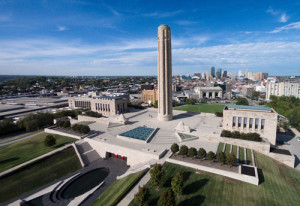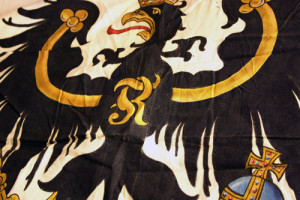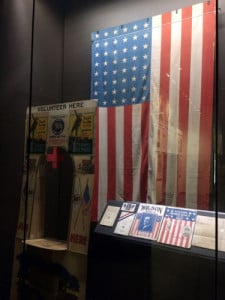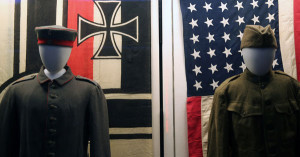WWI flags in focus at Missouri museum

The arrival of Veterans Day calls attention to something that happened 90 years ago on Nov. 11, 1926. That’s when a national museum of World War I opened in Missouri. The conflict itself was spangled with WWI flags.
The National World War I Museum and Memorial, its official name, was sited in Kansas City because its citizens got together two weeks after the 1918 Armistice to raise money in order to honor soldiers who fought and died. According to its website, the museum’s mission is “to honor the memory and sacrifices of all those who served their country and defended liberty during World War I. Additionally, the Museum puts into context the consequences of World War I and how they impact the world we live in today.”

WWI flags fly throughout the museum. Here are three examples on display:
Prussian Flag
One of the European nations entangled in WWI was Prussia. Its 1914 black-and-gold flag sported a fearsome and elaborate Prussian eagle, wearing a crown and grasping an orb and scepter.

Capitol Flag
This American flag flew over the U.S. Capitol on April 2, 1917, the day President Woodrow Wilson addressed Congress about becoming involved in the European conflict. Four days later, war was declared.
A Soldier’s Story
“It is always exciting [to get] a donation with an incredible story,” said Mike Vietti, director of Marketing, Communications and Guest Services at the museum. “While the objects in the donation might seem familiar, it is the history which accompanies [them] that makes [the gift] compelling.”

As an example, Vietti told the story of Christian Nicolaisen, who “was born of Danish parents in German-occupied territory. He went to German schools and was under compulsory German military service when he came of age.” With the outbreak of the war, he was “assigned to the Imperial German Army,” but “he hated everything about his service.” When Christian found out that his brother had died in the war, he got a pass and, in his words, “decided to catch a train north from Hamburg.”
Reaching Denmark, he changed into civvies and sailed to America to stay with another brother. But, when the U.S. entered the war, he was drafted and sent back to Europe, where he was a mechanic.
Vietti noted that “while it cannot be completely verified at this time, Nicolaisen was certainly one of a few, if not the only man, to serve in the German Army followed by the American Army in World War I.”
The soldier’s great-nephew donated to the museum Nicolaisen’s Imperial German tunic, his soft cap, his rifle and other accoutrements, as well as his U.S. service coat, collar disc insignia for the National Army 504th Engineers and his mechanic’s insignia.
“This donation and incredible story of one man’s unique war-time experiences illustrates again the importance of the collections and the exhibitions of the National World War I Museum,” Vietti remarked.
